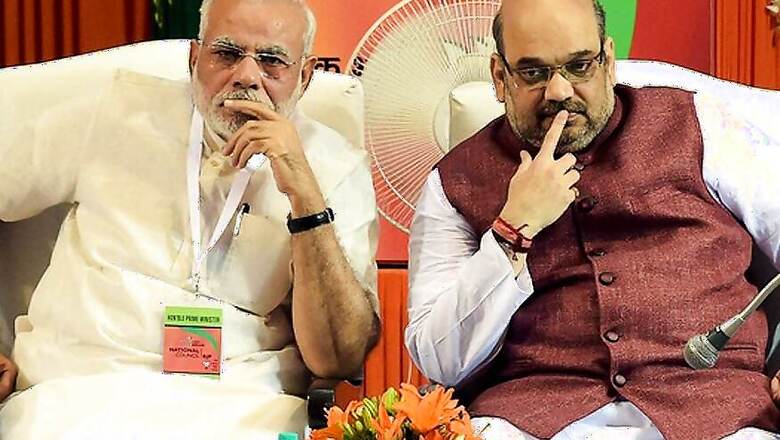
views
Ranchi: Trouncing the Bharatiya Janata Party (BJP), the Jharkhand Mukti Morcha (JMM)-led combine is all set to form the government in Jharkhand after a lapse of nearly five years as the alliance won on 47 seats, forcing the BJP to remain content with just 25.
The speculation over ‘Kaun Banega Mukhyamantri’ in Jharkhand has also been laid to rest post the election results and though the JMM has emerged as the single-largest party, the Congress and RJD may stake claim to key departments when ministries are allocated.
The results have brought much cheer to the JMM but have also come with a lesson for the BJP that the saffron party needs to change its strategy and policies if it wants to perform better in neighbouring Bihar, where elections are due next year.
In Jharkhand, there has been a perceptible shift in the situation from what prevailed before the last two phases of the five-phase state assembly polls. The BJP could save its prestige from a certain washout in the early days before the Citizen Amendment Act (CAA) and the subsequent agitation against it.
The sweep of the JMM-Congress-RJD combine was expected and seemed like a certainty even before polling. However, the bickering among National Democratic Alliance (NDA) allies BJP and AJSU Party, mostly revolving around the question of which ally would field candidates and from where, was like oxygen to the otherwise ‘asphyxiated’ JMM-Congress-RJD combine.
The rabble-rouser Saryu Roy, Independent candidate from Jamshedpur East, pipped chief minister Raghubar Das and said he would support or oppose the policies of the government on its merit.
The Jharkhand results have come as a severe jolt to the BJP after the Maharashtra and Haryana assembly polls did not yield the desired results. The Jharkhand assembly outcome was crucial for the saffron outfit, which expected it to reflect the national mood just five months ago in the Lok Sabha polls.
The results also indicate that emotional issues overweigh local and core issues such as unemployment and economic policies. This was the first election since the Supreme Court passed the Ayodhya judgment, giving the disputed site to the Hindus for the construction of Ram temple. The BJP-led government had also passed the CAA in the midst of the Jharkhand elections.
The elections were crucial for BJP president Amit Shah as they were probably the last polls under his tutelage as party chief, with working president JP Nadda set to take over as the national party president. After stupendous success in the Lok Sabha polls, the last phase of Shah’s stint has seen the saffron party slide in one state after the other.
Jharkhand is one of the country’s poorest states and the ongoing slowdown has likely hit the state harder than the rest of the country. Similarly, unemployment in Jharkhand, and especially rural unemployment, is significantly higher than national levels.
Yet another crucial factor was caste politics and with 28 of the state’s 81-member assembly reserved for STs, the political success of JMM was due to unflinching support from the ST voters. In the previous state elections, the BJP and its ally AJSU were able to secure 30 per cent of the ST votes and 13 ST constituencies.
The BJP has been effective in mobilising non-tribal votes under non-tribal chief minister Raghubar Das. It has disrupted the political pattern in Jharkhand that was carved out of Bihar in 2000, primarily to address the grievances of tribal gentry. Though the BJP secured the votes of other backward classes (OBCs), to which Das belongs, the tribesmen who constitute 30 per cent of the state population seem to have supported the JMM-Congress-RJD combine.
To rope in the support of the OBCs, the Congress had promised in its manifesto 27 per cent reservation for the category from the existing 14 per cent, jobs to at least one person per household and a separate Sarna code (religious code) for the tribal population if voted to power. The JMM too pledged to provide 67 per cent reservation to OBCs, Scheduled Tribes and Scheduled Castes besides government jobs to the local people if it came to power.
The party also promised an allowance of Rs 5,000 and Rs 7,000 per month to unemployed graduates and post-graduates, besides reserving 75 per cent jobs in the private sector for the local youth.
The Congress strategy of promising increase in reservation for the OBCs was a gambit to snatch the OBC quota plank from the BJP and its disgruntled ally, AJSU Party, which has been championing the demand of the Kudmi-Mahato caste for its inclusion in the list of the Scheduled Tribes. The Kudmi-Mahatos constitute around 25 per cent of the total population of Jharkhand.
The BJP had also announced formation of a commission for reservation to backward caste youth and doling out jobs to them. However, opposition from AJSU seems to have scuttled the BJP’s move.
(The author is a senior journalist. Views expressed are personal)




















Comments
0 comment